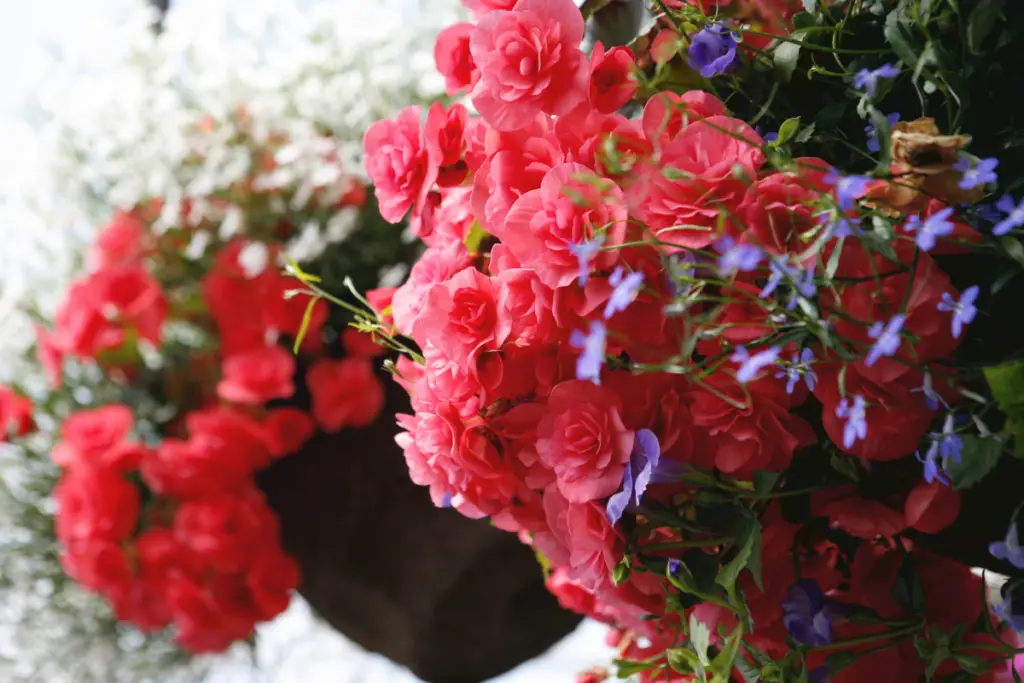Begonia hanging baskets are a popular choice for gardeners who want to add a touch of elegance and color to their outdoor space.
These beautiful plants are known for their vibrant blooms and unique foliage, making them a great addition to any garden or balcony.
However, growing and caring for begonia hanging baskets can be a bit tricky, requiring specific conditions and maintenance.
To start, it’s important to choose the right type of begonia for your hanging basket. While there are many varieties of begonias, not all of them are suited for hanging baskets.
Some of the best options include trailing or cascading begonias, which have a natural tendency to hang down and spill over the edges of the basket.
These types of begonias are perfect for creating a lush, full look in your hanging basket.
When it comes to caring for begonia hanging baskets, there are a few key things to keep in mind.
These plants require regular watering, but it’s important not to overwater them, as this can lead to root rot.
They also need regular fertilization and pruning to promote healthy growth and prevent overcrowding.
With the right care and attention, begonia hanging baskets can thrive and add beauty to your outdoor space for years to come.

Table of Contents
Understanding Begonias
Begonias are a popular choice for gardeners due to their stunning and vibrant blooms. They come in a variety of colors, shapes, and sizes, making them a versatile choice for any garden or hanging basket.
Types of Begonias
There are over 1,000 species of begonias, each with its unique characteristics. However, not all begonias are suitable for hanging baskets. Some of the best types of begonias for hanging baskets include:
- Tuberous begonias: These are known for their large, showy blooms and come in a wide range of colors. They prefer partial shade and well-draining soil.
- Dragon Wing begonias: These are known for their glossy green leaves and bright red or pink flowers. They are easy to care for and prefer partial shade.
- Rieger begonias: These have double blooms and come in a variety of colors, including pink, red, and orange. They prefer bright, indirect light and well-draining soil.
Why Choose Hanging Begonias
Hanging begonias are an excellent choice for gardeners who want to add a pop of color to their outdoor space.
They are easy to care for and require minimal maintenance. Hanging baskets also allow you to grow begonias in small spaces, such as balconies or patios.
In addition, hanging begonias can be used to create stunning displays when combined with other plants. They also provide a beautiful backdrop for other hanging plants, such as ferns or ivy.
Overall, begonia hanging baskets are a great choice for gardeners who want to add a touch of elegance and color to their outdoor space.
With the right care and attention, these plants will thrive and provide you with stunning blooms all season long.
- Lush, Green Foliage: The foliage of the Begonia Apricot is equally stunning. The leaves are large, bright green, and glossy, providing a beautiful backdrop for the Begonia blooms. The leaves are deeply textured, adding an extra layer of visual interest to the plant.
- Extended Bloom Time: Begonia Apricot have a long blooming season, beginning in mid-summer and continuing until the first frost. This extended bloom time makes them an excellent choice for adding color and texture to the garden or home throughout the growing season.
- Cascading Habit: The stems of the Begonia Apricot can grow up to 50cm long, giving the plant a cascading habit. This makes them perfect for hanging baskets or containers, where they can trail over the edges and add height and texture to any arrangement.
- Stunning Blooms: The blooms of the Begonia Apricot are one of their most striking features. These large, showy flowers measure up to 10cm in diameter and feature numerous petals, which are reminiscent of miniature roses. They are sure to be a standout feature in any garden or indoor setti
Prices pulled from the Amazon Product Advertising API on:
Product prices and availability are accurate as of the date/time indicated and are subject to change. Any price and availability information displayed on [relevant Amazon Site(s), as applicable] at the time of purchase will apply to the purchase of this product.
Growing Hanging Begonias
Hanging begonias are a popular choice for gardeners who want to add a splash of color to their outdoor space.
These plants are easy to care for and can thrive in a variety of conditions.
In this section, we will discuss the ideal conditions for growing hanging begonias, as well as the planting process.
Ideal Conditions
To grow healthy and vibrant hanging begonias, it’s important to provide them with the ideal conditions.
These plants prefer a partially shaded area with well-draining soil. They can also tolerate full sun, but only if they are watered regularly.
The ideal temperature range for hanging begonias is between 60-75°F. They can tolerate slightly cooler temperatures, but they may not grow as quickly.
It’s important to keep the soil moist, but not waterlogged. Overwatering can lead to root rot and other issues.
Planting Process
When planting hanging begonias, it’s important to choose a container that is the right size for the plant.
A container that is too small can restrict the growth of the plant, while a container that is too large can lead to overwatering.
Fill the container with a well-draining soil mix, and add a slow-release fertilizer. Make sure the soil is moist before planting the begonia.
When planting, make sure the root ball is level with the soil surface.
After planting, water the begonia thoroughly and place it in a partially shaded area. If the plant is in full sun, make sure to water it more frequently.
Deadheading the plant regularly will encourage new growth and keep the plant looking healthy.
In conclusion, growing hanging begonias is an easy and rewarding experience.
By providing the plant with the ideal conditions and following the proper planting process, gardeners can enjoy beautiful blooms all season long.
Caring for Hanging Begonias
Hanging begonias are beautiful and easy to care for flowering plants that can add a splash of color to any garden or patio.
Proper care is essential for their growth and longevity. Here are some tips on how to care for hanging begonias.
Watering Needs
Hanging begonias require regular watering to keep the soil moist but not waterlogged. The frequency of watering depends on the climate, humidity, and soil conditions.
In general, they need to be watered once a week, but during hot and dry weather, they may need to be watered more frequently.
It is important to avoid letting the soil dry out completely, as this can cause the leaves and flowers to wilt and fall off.
Fertilizing Needs
Hanging begonias benefit from regular fertilization to promote healthy growth and abundant blooms.
A balanced fertilizer with equal parts nitrogen, phosphorus, and potassium is recommended. Fertilize once a month during the growing season, from spring to fall.
It is important to follow the manufacturer’s instructions when applying fertilizer, as over-fertilization can damage the plant.
Pruning and Maintenance
Pruning is essential for maintaining the shape and size of hanging begonias. Pinching off the tips of the stems encourages bushy growth and more flowers.
Deadheading, or removing spent flowers, also promotes the growth of new blooms.
Regular maintenance, such as removing yellow or damaged leaves, helps keep the plant healthy and attractive.
In conclusion, caring for hanging begonias is not difficult, but it requires attention to watering, fertilizing, pruning, and maintenance.
With proper care, these beautiful plants can thrive and provide a stunning display of color and foliage.
Common Problems and Solutions
Begonias are susceptible to pests and diseases, which can lead to stunted growth or even death of the plant.
Here are some common problems that you may encounter with your begonia hanging basket plants and their solutions.
Pest Control
Pests like aphids, mealybugs, and spider mites can infest your begonia plants, causing damage to the leaves and flowers.
To control these pests, you can use insecticidal soap or neem oil. These natural remedies are effective in killing the pests without harming the plant.
Another effective way to control pests is by using a systemic insecticide. This type of insecticide is absorbed by the plant and is effective in killing pests for several weeks.
However, be careful when using systemic insecticides, as they can be harmful to beneficial insects like bees and butterflies.
Disease Prevention
Begonias are prone to diseases like powdery mildew, botrytis, and bacterial leaf spot. To prevent these diseases, make sure to provide good air circulation around your plants.
Avoid overcrowding your plants and remove any dead or infected leaves.
Watering your plants properly can also help prevent diseases. Overwatering can lead to root rot, which can weaken the plant and make it more susceptible to diseases.
Water your plants only when the soil is dry to the touch.
If you notice any signs of disease, such as yellowing leaves or powdery growth on the leaves, remove the affected leaves immediately. You can also use a fungicide to control the spread of the disease.
In summary, proper pest control and disease prevention are essential for the health and longevity of your begonia hanging basket plants.
By following these tips, you can ensure that your plants thrive and produce beautiful blooms.
Conclusion
In conclusion, growing and caring for Begonia hanging baskets can be a rewarding experience. With the right conditions and proper care, these plants can thrive and produce beautiful blooms that can add color and life to any space.
When choosing a location for your Begonia hanging basket, it is important to consider the light requirements of the plant.
Begonias prefer bright, indirect light and should be protected from direct sunlight, which can scorch their leaves.
Watering your Begonia hanging basket is also important. These plants prefer soil that is moist but not waterlogged.
It is important to avoid letting the soil dry out completely between waterings, as this can cause stress to the plant.
Fertilizing your Begonia hanging basket can also help promote healthy growth and blooms. A balanced fertilizer can be applied every two to four weeks during the growing season.
Finally, trimming and other care for your Begonia hanging basket can help keep it looking its best.
Deadheading spent blooms and removing any damaged or diseased leaves can help promote healthy growth and prevent the spread of disease.
Overall, with proper care and attention, Begonia hanging baskets can be a beautiful and rewarding addition to any home or garden.
- How to Dry Basil Leaves: A Professional Guide
- Is an Avocado a Fruit or Vegetable? Simple Answer and Explanation
- Does Pineapple Have Seeds? Exploring the Anatomy of Pineapples
- Blooming Through Winter: Can I Grow Vegetables Indoors in the Winter?
- What Can You Grow in a Greenhouse All Year Round: A Guide to Year-Round Greenhouse Gardening
- Are Blueberries Blue? Debunking the Myth of Their Color

















